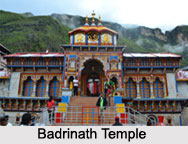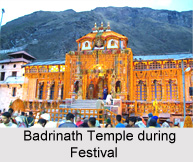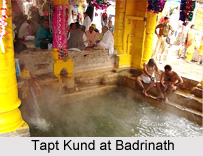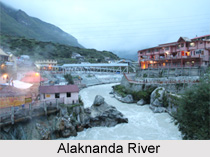 Badrinath Temple is a Hindu temple dedicated to Lord Vishnu. It is also called "Badrinarayan Temple". The temple is located in Garhwal hill tracks along the banks of the Alaknanda River in Chamoli district in the north Indian state of Uttarakhand. The hill tracks are located 10,279 ft above the mean sea level. The "Nar Parbat Mountain" is located opposite to the temple, while the "Narayana Parbat" is located behind the "Neelakantha Peak" in the Himalayan region. The temple is considered one of the holiest Hindu sites "Char Dham" (four divine), comprising "Rameswaram", "Badrinath", "Puri" and "Dwarka".
Badrinath Temple is a Hindu temple dedicated to Lord Vishnu. It is also called "Badrinarayan Temple". The temple is located in Garhwal hill tracks along the banks of the Alaknanda River in Chamoli district in the north Indian state of Uttarakhand. The hill tracks are located 10,279 ft above the mean sea level. The "Nar Parbat Mountain" is located opposite to the temple, while the "Narayana Parbat" is located behind the "Neelakantha Peak" in the Himalayan region. The temple is considered one of the holiest Hindu sites "Char Dham" (four divine), comprising "Rameswaram", "Badrinath", "Puri" and "Dwarka".
History of Badrinath Temple
There is no historical record about the temple, but there is a mention of the presiding deity Badrinath in Vedic scriptures, indicating the presence of the temple during the Vedic period (1750-500 BC). As per its architecture, the temple was a Buddhist shrine till the 8th century and Adi Shankaracharya converted it to a Hindu temple. The brightly painted facade which is similar to other Buddhist temples leads to the argument. It is believed that Shankaracharya resided in the place for 6 years from 814 to 820 AD. He resided 6 months in Badrinath and the rest of the year in Kedarnath. Hindu followers assert that he discovered the image of Badrinath in the Alaknanda River and enshrined it in a cave near the Tapt Kund hot springs.
 Legend of Badrinath Temple
Legend of Badrinath Temple
According to Hindu legend, Lord Vishnu sat in meditation at this place. During his meditation, Vishnu was unaware of cold weather. Lakshmi, his consort, protected him in the form of the Badri tree. Pleased by the devotion of Lakshmi, Vishnu named the place "Badrika Ashram".
 According to Vishnu Purana, Dharam had 2 sons, Nar and Narayan - both of which are modern names of Himalayan Mountains. They chose the place to spread their religion and each of them wed the spacious valleys in the Himalayas. Searching for an ideal place to set up a hermitage, they came across the other 4 Badris of the "Pancha Badri", namely "Bridha Badri", "Yog Bhadri", "Dhyan Badri" and "Bhavish Badri". They finally found the hot and cold spring behind the Alaknanda River and named it "Badri Vishal". The temple finds mention in several ancient books like Bhagavata Purana, Skanda Purana and Mahabharata.
According to Vishnu Purana, Dharam had 2 sons, Nar and Narayan - both of which are modern names of Himalayan Mountains. They chose the place to spread their religion and each of them wed the spacious valleys in the Himalayas. Searching for an ideal place to set up a hermitage, they came across the other 4 Badris of the "Pancha Badri", namely "Bridha Badri", "Yog Bhadri", "Dhyan Badri" and "Bhavish Badri". They finally found the hot and cold spring behind the Alaknanda River and named it "Badri Vishal". The temple finds mention in several ancient books like Bhagavata Purana, Skanda Purana and Mahabharata.
Architecture of Badrinath Temple
Badrinath Temple has three structures; the "Garbagriha", the "Darshan Mandap" and "Sabha Mandap". The conical shaped roof of the sanctum, the Garbagriha, is approximately 15 m tall with a small cupola on top, covered with a gold gilt roof. The facade is built of stone and has arched windows. A broad stairway leads up to the main entrance arched gateway. Just inside is a mandap, a large, pillared hall that leads to the main shrine area. The walls and pillars of the hall are covered with intricate carvings.
Deities of Badrinath Temple
The main shrine houses the image of the presiding deity worshipped in the temple that is a 1m tall black stone statue of Vishnu in the form of Badrinarayan in a gold canopy under a Badri Tree. The sanctum also houses images of the god of wealth - Kubera, sage Narada, Uddhava, Nar and Narayan. There are 15 more images that are also worshipped around the temple. These include that of Lakshmi, Garuda and Navadurga, the manifestation of Goddess Durga in 9 different forms. The temple also has shrines for saints Adi Shankaracharya, Vedanta Desika and Ramanujacharya. All the idols of the temple are made of black stone.
 Pilgrimages near Badrinath Temple
Pilgrimages near Badrinath Temple
The Char Dham Yatra is a Hindu pilgrimage. There are four abodes in the Himalayas called Chota Char Dham: Badrinath, Kedarnath, Gangotri and Yamunotri-all of which lie in the foothills of the Himalayas. As the number of pilgrims to these places has increased in modern times, it is called Himalayan Char Dham. The journey across the four cardinal points in India is considered sacred by Hindus, who aspire to visit these temples once in their lifetimes.
Festivals at Badrinath Temple
The most prominent festival held at Badrinath Temple is "Mata Murti Ka Mela", which commemorates the descent of the Ganga River on mother earth. The mother of Badrinath, who is believed to have divided the river into 12 channels for the welfare of earthly beings, is worshiped during the festival.
The "Badri-Kedar" festival is celebrated during the month of June in both the temple and the Kedarnath Temple which lasts for eight days. The temple is one of the holy places where the Hindus offer oblations to ancestors with the help of the priests.





















